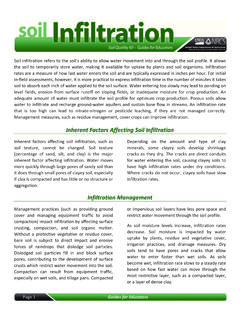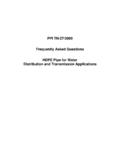Transcription of Permeation & Leaching - US EPA
1 _____. Office of Water (4601M). Office of Ground Water and Drinking Water Distribution System Issue Paper Permeation and Leaching August 15, 2002. PREPARED FOR: Environmental Protection Agency Office of Ground Water and Drinking Water Standards and Risk Management Division 1200 Pennsylvania Ave., NW. Washington DC 20004. Prepared by: AWWA. With assistance from Economic and Engineering Services, Inc Background and Disclaimer The USEPA is revising the Total Coliform Rule (TCR) and is considering new possible distribution system requirements as part of these revisions.
2 As part of this process, the USEPA is publishing a series of issue papers to present available information on topics relevant to possible TCR revisions. This paper was developed as part of that effort. The objectives of the issue papers are to review the available data, information and research regarding the potential public health risks associated with the distribution system issues, and where relevant identify areas in which additional research may be warranted. The issue papers will serve as background material for EPA, expert and stakeholder discussions.
3 The papers only present available information and do not represent Agency policy. Some of the papers were prepared by parties outside of EPA;. EPA does not endorse those papers, but is providing them for information and review. Additional Information The paper is available at the TCR web site at: Questions or comments regarding this paper may be directed to Permeation & Leaching General Description of Topics Distribution system infrastructure and appurtenances, including piping, linings, fixtures, and solders, can react with the water they supply as well as the external environment.
4 These interactions can result in degradation of the distributed water. Permeation of plastic pipes and Leaching from linings and metal appurtenances are known pathways for water quality degradation. Permeation of piping materials and non-metallic joints can be defined as the passage of contaminants external to the pipe, through porous, non-metallic materials, into the drinking water. The problem of Permeation is generally limited to plastic, non-metallic materials. Leaching can be defined as the dissolution of metals, solids, and chemicals into drinking water.
5 (Symons et al, 2000). Leaching can result in elevated levels of metals, organic contaminants, or asbestos in water consumed at the tap. Health effects and mitigation techniques related to Leaching of lead and copper from lead service lines or household plumbing materials are addressed in the Lead and Copper Rule (USEPA, 1991). Health effects associated Leaching of asbestos fibers from asbestos-cement piping is currently addressed under the Phase II National Primary Drinking Water Regulations (USEPA, 1991). Thus, this White Paper will focus on Leaching and Permeation of organic contaminants and other metals.
6 Permeation of Piping and Non-Metallic Joints Permeation is a physicochemical mass transfer phenomenon involving diffusion of a solute through a porous medium. The driving force for mass transfer is the presence of an activity ( , concentration) gradient with respect to the solute. The rate of Permeation can be generalized in simple mathematical terms shown in Equation 1. (1) N = UA ( a). where: N = Mass Permeation Rate U = Overall Mass Transfer Coefficient A = Transfer Area a = Solute Activity The overall mass transfer coefficient (U) is a complex function of the following variables: Solute properties (composition, phase).
7 Medium properties (composition, pore structure, swollenness). Solute-medium interaction (equilibrium partitioning, diffusion coefficient). Pipe flow hydrodynamics (Reynolds number). Transfer geometry (medium thickness). Environmental conditions (temperature). Prepared by AWWA with assistance from Economic and Engineering Services, Inc. 1. Permeation of potable water mains and distribution system fittings by external contaminants can be viewed as a three-step process. First, the solute partitions between the external bulk phase ( , pore water, soil) and the pipe wall exterior.
8 Next, the solute diffuses through the pore structure of the pipe or fitting. Finally, upon penetration the solute partitions between the internal bulk phase ( , pipe water) and the pipe wall interior. Permeation can occur either from the vapor or aqueous phase. With respect to Permeation of potable water mains, the contaminants of interest include highly volatile hydrocarbons and organic solvents. Therefore, both water mains and fittings installed in the vadose and saturated zones are susceptible to contamination by Permeation (DWI0441, 1992).
9 Metals and Chemical Leaching Leaching is a broad category that includes the dissolution of a variety of metals and chemicals into drinking water. In some instances, it is difficult to differentiate between corrosion and Leaching . Studies have been conducted to determine the rate and extent of Leaching from metallic, plastic, and concrete pipes, as well as various coatings, linings, and sealants. Coatings and linings are often employed to prevent corrosion of water mains and mitigate red water problems. Among the more common linings are epoxy resins, cement-mortar, asphalt (bituminous), and concrete.
10 Description of Potential Water Quality Problems Table 1 provides a summary of potential water quality problems associated with Permeation and Leaching . Table 1. Summary of Potential Water Quality Problems Permeation Leaching 2. Increased VOC content of distributed water Increased lead and copper levels1. Vinyl Chloride formation2 Increased asbestos levels1. Aesthetic issues (taste, odor, film formation) Increased organic contaminants from PE pipe2. Increased metals levels from cement pipe or linings2. Increased organic contaminants from organic linings2.












